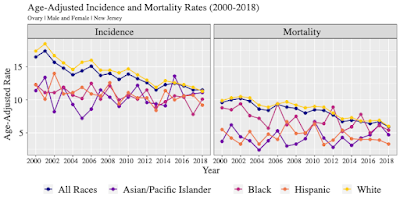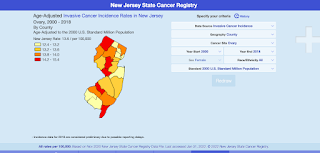Since my diagnosis, I have followed the statistics for those diagnosed with ovarian cancer. When I was initially diagnosed in 2005, ACS estimated that the number of women diagnosed with ovarian cancer in NJ would be ~ 700. But I often wonder if the number has changed since I was initially diagnosed. I also wondered where women diagnosed with ovarian cancer lived in NJ. Were women in some counties being diagnosed more frequently than in other counties? What about women diagnosed with cervical cancer or endometrial ( uterine ) cancer? Did their diagnosis vary by county?
I recently received an email from Dr Anita Kinney (Director of the Cancer Health Equity Center of Excellence) announcing the launch of the STRIDE Interactive Data Dashboard by the Rutgers Cancer Institute of NJ Community Outreach and Engagement Team and the Cancer Health Equity Center of Excellence.
"Surveillance, Tracking and Reporting through Informed Data Collection and Engagement (STRIDE) is an interactive data and visualization dashboard (public and institution versions) that includes clinical trials enrollment, biospecimen inventory, tumor registry analytic cases, catchment area information related to the cancer burden, behavioral and environmental risk factors, and demographics.
Features include :
"Cancer Surveillance: Incidence and mortality rates on state and county levels. Cancer screening rates and risk factors are also featured on STRIDE.
User Input Customization: Users can easily filter data to create interactive visualizations.
Interactive Mapping: Interactive maps include census tract level population and environmental data."To access the public side of the website please visit https://published.cinj.
I used the site to find data for cancer of the ovary incidence and mortality rate in NJ and downloaded this graph.
I invite you to check out STRIDE as well as the NJ Cancer Registry website ( https://www.cancer-rates.info/nj/) for information such as incidence per county in map form. I grabbed a screenshot of the cancer of the ovary Incidence Rates (2000-2018). As you can see some counties have higher incidence rates of cancer of the ovary than others. Similar maps will be available on STRIDE.
Then I looked at cancer of the cervix for the same years and you can see how the incidence rates in the counties differ from ovarian cancer.
What measures can we take to reach people to raise awareness and treat those diagnosed in those counties? What causes those counties to have higher rates? Environmental issues? Socio-economic issues?
This data will help researchers target areas of my state where services and education need to be increased.
Does you state have cancer data sites like this one?
Dee
Every Day is a Blessing!



No comments:
Post a Comment